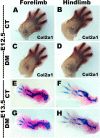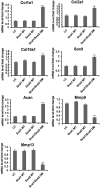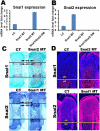Compensatory regulation of the Snai1 and Snai2 genes during chondrogenesis
- PMID: 23322385
- PMCID: PMC3663919
- DOI: 10.1002/jbmr.1871
Compensatory regulation of the Snai1 and Snai2 genes during chondrogenesis
Abstract
Endochondral bone formation is a multistep process during which a cartilage primordium is replaced by mineralized bone. Several genes involved in cartilage and bone development have been identified as target genes for the Snail family of zinc finger transcriptional repressors, and a gain-of-function study has demonstrated that upregulation of Snai1 activity in mouse long bones caused a reduction in bone length. However, no in vivo loss-of-function studies have been performed to establish whether Snail family genes have an essential, physiological role during normal bone development. We demonstrate here that the Snai1 and Snai2 genes function redundantly during embryonic long bone development in mice. Deletion of the Snai2 gene, or limb bud-specific conditional deletion of the Snai1 gene, did not result in obvious defects in the skeleton. However, limb bud-specific Snai1 deletion on a Snai2 null genetic background resulted in substantial defects in the long bones of the limbs. Long bones of the Snai1/Snai2 double mutants exhibited defects in chondrocyte morphology and organization, inhibited trabecular bone formation, and delayed ossification. Chondrocyte proliferation was markedly reduced, and transcript levels of genes encoding cell cycle regulators, such as p21(Waf1/Cip1) , were strikingly upregulated in the Snai1/Snai2 double mutants, suggesting that during chondrogenesis Snail family proteins act to control cell proliferation by mediating expression of cell-cycle regulators. Snai2 transcript levels were increased in Snai1 mutant femurs, whereas Snai1 transcript levels were increased in Snai2 mutant femurs. In addition, in the mutant femurs the Snai1 and Snai2 genes compensated for each other's loss not only quantitatively, but also by expanding their expression into the other genes' normal expression domains. These results demonstrate that the Snai1 and Snai2 genes transcriptionally compensate temporally, spatially, and quantitatively for each other's loss, and demonstrate an essential role for Snail family genes during chondrogenesis in mice.
Copyright © 2013 American Society for Bone and Mineral Research.
Figures







Similar articles
-
The SNAI1 and SNAI2 proteins occupy their own and each other's promoter during chondrogenesis.Biochem Biophys Res Commun. 2013 Jun 7;435(3):356-60. doi: 10.1016/j.bbrc.2013.04.086. Epub 2013 May 7. Biochem Biophys Res Commun. 2013. PMID: 23665016 Free PMC article.
-
Comparative genomics on SNAI1, SNAI2, and SNAI3 orthologs.Oncol Rep. 2005 Oct;14(4):1083-6. Oncol Rep. 2005. PMID: 16142376
-
Multiple functions of Snail family genes during palate development in mice.Development. 2007 May;134(9):1789-97. doi: 10.1242/dev.02837. Epub 2007 Mar 21. Development. 2007. PMID: 17376812
-
Functions of the SNAI family in chondrocyte-to-osteocyte development.Ann N Y Acad Sci. 2021 Nov;1503(1):5-22. doi: 10.1111/nyas.14668. Epub 2021 Aug 17. Ann N Y Acad Sci. 2021. PMID: 34403146 Review.
-
[SNAI1 and SNAI2 - transcriptional master-regulators of epithelial-mesenchimal transition].Patol Fiziol Eksp Ter. 2015 Apr-Jun;59(2):76-87. Patol Fiziol Eksp Ter. 2015. PMID: 26571812 Review. Russian.
Cited by
-
Epithelial-to-mesenchymal transition transcription factors: New strategies for mesenchymal tissue regeneration.Cytokine Growth Factor Rev. 2025 Jun;83:99-124. doi: 10.1016/j.cytogfr.2025.02.001. Epub 2025 Feb 19. Cytokine Growth Factor Rev. 2025. PMID: 40011185 Review.
-
Stromal SNAI2 Is Required for ERBB2 Breast Cancer Progression.Cancer Res. 2020 Dec 1;80(23):5216-5230. doi: 10.1158/0008-5472.CAN-20-0278. Epub 2020 Oct 6. Cancer Res. 2020. PMID: 33023950 Free PMC article.
-
Snail/Slug binding interactions with YAP/TAZ control skeletal stem cell self-renewal and differentiation.Nat Cell Biol. 2016 Sep;18(9):917-29. doi: 10.1038/ncb3394. Epub 2016 Aug 1. Nat Cell Biol. 2016. PMID: 27479603 Free PMC article.
-
Robust bioengineered 3D functional human intestinal epithelium.Sci Rep. 2015 Sep 16;5:13708. doi: 10.1038/srep13708. Sci Rep. 2015. PMID: 26374193 Free PMC article.
-
Unraveling the Roles of miR-204-5p and HMGA2 in Papillary Thyroid Cancer Tumorigenesis.Int J Mol Sci. 2023 Jun 28;24(13):10764. doi: 10.3390/ijms241310764. Int J Mol Sci. 2023. PMID: 37445942 Free PMC article.
References
-
- Hartmann C. Transcriptional networks controlling skeletal development. Curr Opin Genet Dev. 2009;19:437–43. - PubMed
-
- Karsenty G, Kronenberg HM, Settembre C. Genetic control of bone formation. Annu Rev Cell Dev Biol. 2009;25:629–48. - PubMed
-
- Barrallo-Gimeno A, Nieto MA. The Snail genes as inducers of cell movement and survival: implications in development and cancer. Development. 2005;132:3151–61. - PubMed
Publication types
MeSH terms
Substances
Grants and funding
LinkOut - more resources
Full Text Sources
Other Literature Sources
Molecular Biology Databases
Research Materials

